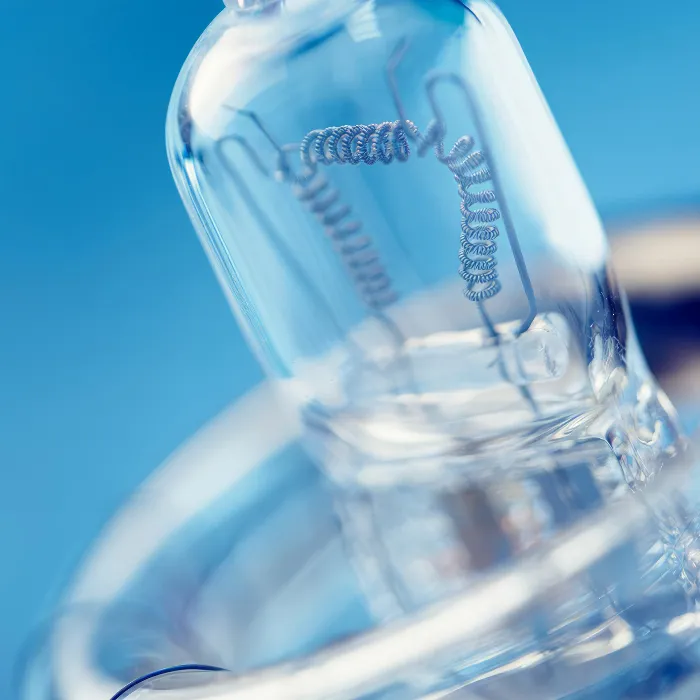Light sources relevant for professional photography
Figure 3.1: It also makes a difference in terms of lighting technology whether you are photographing cars, people or stills. The photographic themes that the photographer wants to focus on are therefore included in the requirements profile. The photographer's personal (lighting) taste also plays a not insignificant role in the choice of lighting technology: some prefer hard light, some soft. Some prefer clear lighting, others like to work with lots of effect lights.
And finally, the individual way of working must be taken into account: If the photographer is a lone wolf and constantly on location, they will prefer a different lighting technique than someone who works in a studio or always has helpers around them. Someone who takes a lot of time with their shots will attach importance to different things than someone who has to have the photos in the can in the shortest possible time. All of this together results in a requirements profile that needs to be matched with the lighting technology options available on the market.
Ultimately, it is important to find the optimum lighting technology for the individual photographer. And last but not least, a limited financial budget will mean that not everything that seems sensible and permanently necessary can be purchased immediately. It is then necessary to cut back on the scope or, if necessary (!), the quality of the lighting technology that can be purchased.
Note
There are largely "optimal" lighting solutions for every photographer and some that are absolutely unsuitable for personal requirements. And a lot in between. It is therefore important to work out a requirements profile to determine which lighting technology makes sense for the photographer in question.
Together with the available budget, the requirements profile then determines which equipment should and can be purchased. There is now a lot of very good lighting technology for photographers on the market. There is something suitable for every requirement. However, don't just buy according to the "price" criterion, because: "If you buy cheap, you buy twice!"
Figure 3.2: Unlike modern cameras, which become obsolete after a few years and have to be bought new, lighting technology ages much more slowly. Parts of my flash system are already 15 years old and I will certainly be able to work with them for the next 15-20 years without any compromises.
Lighting technology is therefore a long-term investment. If you buy quality, you can expect to use it for 30 years or even longer.
I therefore recommend that if you have a limited budget, it is better to buy something sensible for less than to buy everything at once in poor quality. In the course of this tutorial series, I will go into more detail about the lighting technology I have tested and recommend as part of a purchase recommendation.
If you need individual advice, I can help you choose the equipment that best suits your needs in a one-to-one training session. In contrast to cameras, of which there are plenty of tests in photo magazines, purchasing advice on lighting accessories is rather scarce.
Many salespeople lack the appropriate, tried-and-tested know-how and the photo magazines usually only list the technical data.
Real tests are virtually non-existent, meaning that prospective buyers are usually left to their own devices and helplessly search the internet for answers. However, an individual selection and compilation is necessary so that you can work optimally with the purchased system later on. If you also consider the purchase costs, it quickly becomes clear that you should obtain sufficient information before buying in order to get the best value for money. As already emphasized: High-quality lighting technology can generally be used for several decades.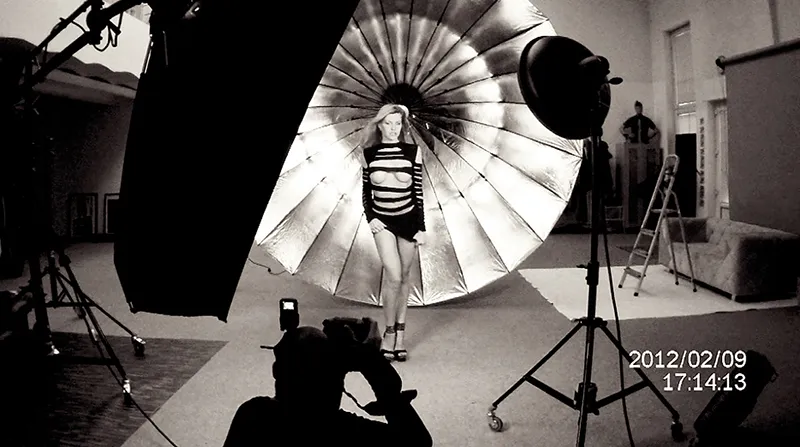
(Photo © 2012: Jens Brüggemann - http://www.jensbrueggemann.de)
Figure 3.3: Many photographers, unaware of how flash systems work, seek their salvation in the use of continuous light. But are continuous light sources really suitable for photographic purposes? This tutorial provides information on which light should be used for which purposes in order to achieve optimum results.
(Photo © 2013: Jens Brüggemann - http://www.jensbrueggemann.de)
3.1 Available light
Available light refers to the available (continuous) light. In photography, this term is associated with the fact that the light is not only available, but also relatively weak. This excludes strong light sources such as direct sunlight or the floodlights in a soccer stadium from this definition.
Due to the advanced technology of modern cameras with the possibilities of high ISO settings with good to acceptable image quality, the conditions have also shifted where one can still speak of available light. Or to put it another way: With high ISO values, there are many more possibilities than a few years ago to take pictures with available low light. Now, with modern cameras, it is really possible to take pictures in low light conditions where a few years ago you would have been at a loss without a tripod. This opens up a whole new range of possibilities that seemed unthinkable in the days of analog photography!
Figure 3.4: This photo was taken in a cave with lots of stalactites and stalagmites. The cave was illuminated and I didn't use a flash to avoid destroying the lighting mood. To avoid camera shake, I propped the camera on a rock in the foreground. Nikon D200 with 2.8/20mm Nikkor. 1/8 sec, Blender 4.0.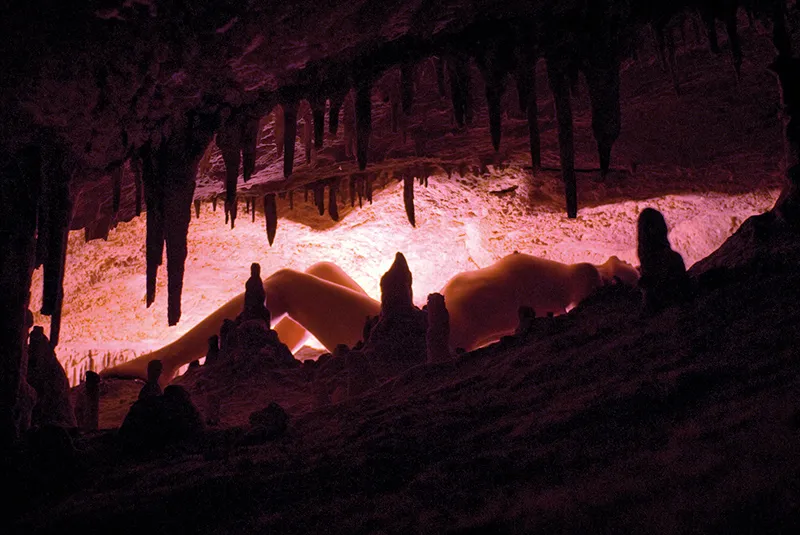
(Photo ©: Jens Brüggemann - http://www.jensbrueggemann.de)
Since available light includes both daylight and artificial light, it is important to pay attention to any color casts that may occur. Sometimes, however, it can make sense to leave the camera's color temperature setting at daylight and consciously accept a color cast. Especially in mixed light situations, it can be nice to be able to recognize the (warmer) artificial light (also as such) in addition to the little daylight.
Color temperature
The color temperature of a light source is specified in Kelvin (K).
0 K corresponds to a body that does not emit any radiation and absorbs all incident radiation.
- According to the international definition, average, "neutral" daylight has 5,500 K. This is what films and digital cameras/backlights are optimized for.
- Artificial light ("continuous light") is between 1,500 - 3,400 K.
- Depending on the time of day and weather, natural daylight varies from 3,400 K (late evening sun) to 4,800 K (sunrise/sunset) to 12,000 K ("blue hour").
- Clip-on and rod flash units achieve a color temperature of up to 6,000 K.
- The use of filters, whether on the light source or the lens, merely attenuates the complementary color components, but does not add any color range (light)!
Source: Guido Puttkammer: "Basisseminar", Profoto 2005.
Conclusion: Photography without available light is inconceivable. There has always been the appeal of atmospherically exposed photos taken in available light, at the limits of what is possible, so to speak.
Figure 3.5: Shot alone in candlelight, photographed freehand without a tripod. Nikon D3 with 2.8/105mm Micro Nikkor. 1/60 second, Blender 4.5, ISO 2,500.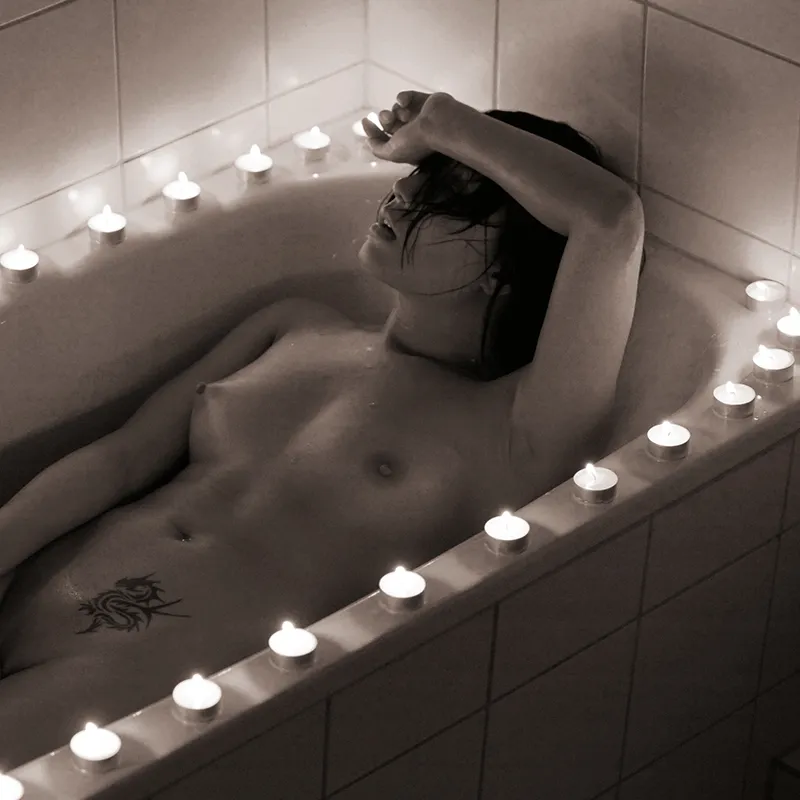
(Photo ©: Jens Brüggemann - http://www.jensbrueggemann.de)
3.2 Light bulbs
When an EU regulation banned the sale of conventional light bulbs for normal consumers, a clever entrepreneur came up with the idea of introducing them as "small heating plants" and offering them for sale.
The entrepreneur lost in court, but basically he was right (technically speaking): incandescent lamps, which are still allowed to be sold for special applications (for example as modeling lights for flash units), are primarily heat emitters and only secondarily do they provide light. The efficiency of incandescent lamps is extremely low at between 4-8% visible light. They are rightly dubbed "electricity wasters and polluters".
However, incandescent lamps have other disadvantages in addition to their high heat output. Their color temperature, with values between 2,800 K and 3,200 K, is extremely low (warm). If they are dimmed, the color temperature drops further (the light becomes even warmer in terms of color characteristics).
It is also not constant, neither with increasing operating time nor in the life cycle of the bulb, which is why it is not suitable for photographs where the "lightfastness" of the photographed objects is important (such as in advertising product photography). In addition to the color temperature, the output also fluctuates, both over the period of use and with power fluctuations in the grid.
Figure 3.6: Due to their many disadvantages, incandescent lamps should only be used in photography to provide (atmospheric) backlighting. They are not suitable as main light.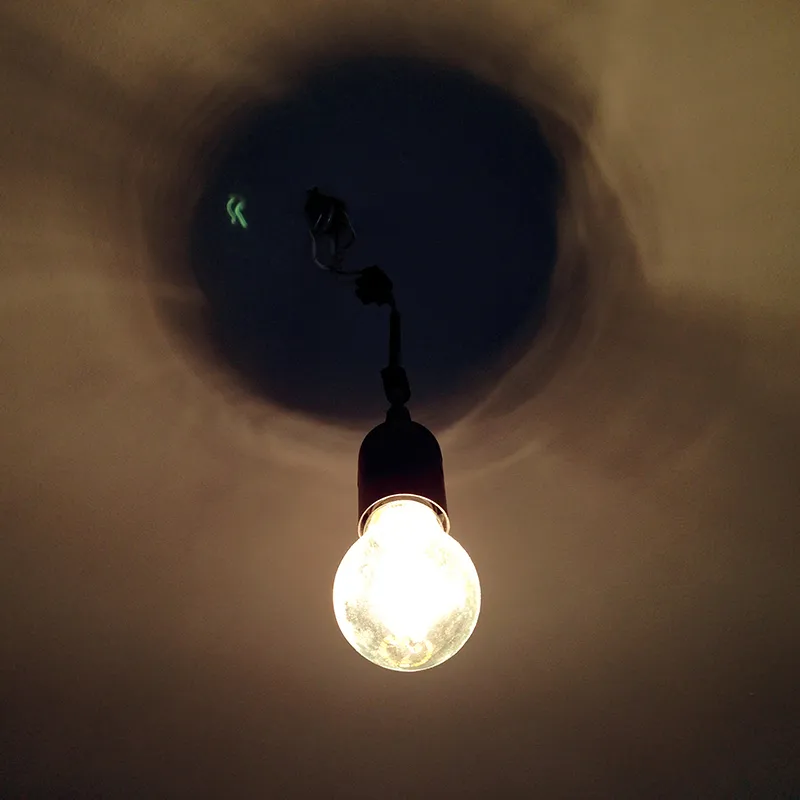
(Photo © 2013: Jens Brüggemann - http://www.jensbrueggemann.de)
But incandescent lamps also have advantages: they are inexpensive, do not weigh much, you can see their light curve and the mixed light distribution in daylight (combination of continuous light 1 and continuous light 2). And their light can be measured using the automatic exposure controls built into the cameras. This makes them particularly interesting for photographers who prefer to work according to the WYSIWYG ("What you see is what you get") principle (although the different color temperature must be taken into account).
3.3 Construction spotlights & Co.
For some reason, construction spotlights are popular with amateur photographers. Their apparently simple operation coupled with a low purchase price and compact dimensions of the lamp make them the first choice for photographers who want to start creating with light. But are the construction spotlights, which are usually fitted with halogen lamps, really suitable for photographic purposes?
Halogen lamps are cheap to buy and there is a wide range available. Some construction spotlights are sold complete with tripod. They are often splash-proof and therefore also suitable for outdoor use. Output and color temperature remain relatively constant over the entire burning time. As with incandescent lamps, their light can also be measured with the built-in light meter (continuous light).
The disadvantages, on the other hand, make it clear why construction spotlights were designed for "brightening up" construction sites - and not for photographic purposes: their efficiency is very low at around 10%. Heat development, on the other hand, is very high, especially at high power, which limits their use in combination with light shapers to an absolute minimum (or makes it almost impossible with attachments made of fabric).
The torch can easily be damaged by vibrations, so its robustness is limited. The color temperature is very low (between 3,200 K - 3,400 K), resulting in "warm" light. (When dimming, if at all possible, it decreases even further).
This can be particularly annoying in mixed light situations (halogen light with daylight), as the white balance on the camera can be set to either daylight or halogen light (or you can select a value approximately in between, which is also not ideal).
Figure 3.7: Lighting with construction spotlights or other halogen lamps is rather unsuitable for photographing products that are to be reproduced in true color.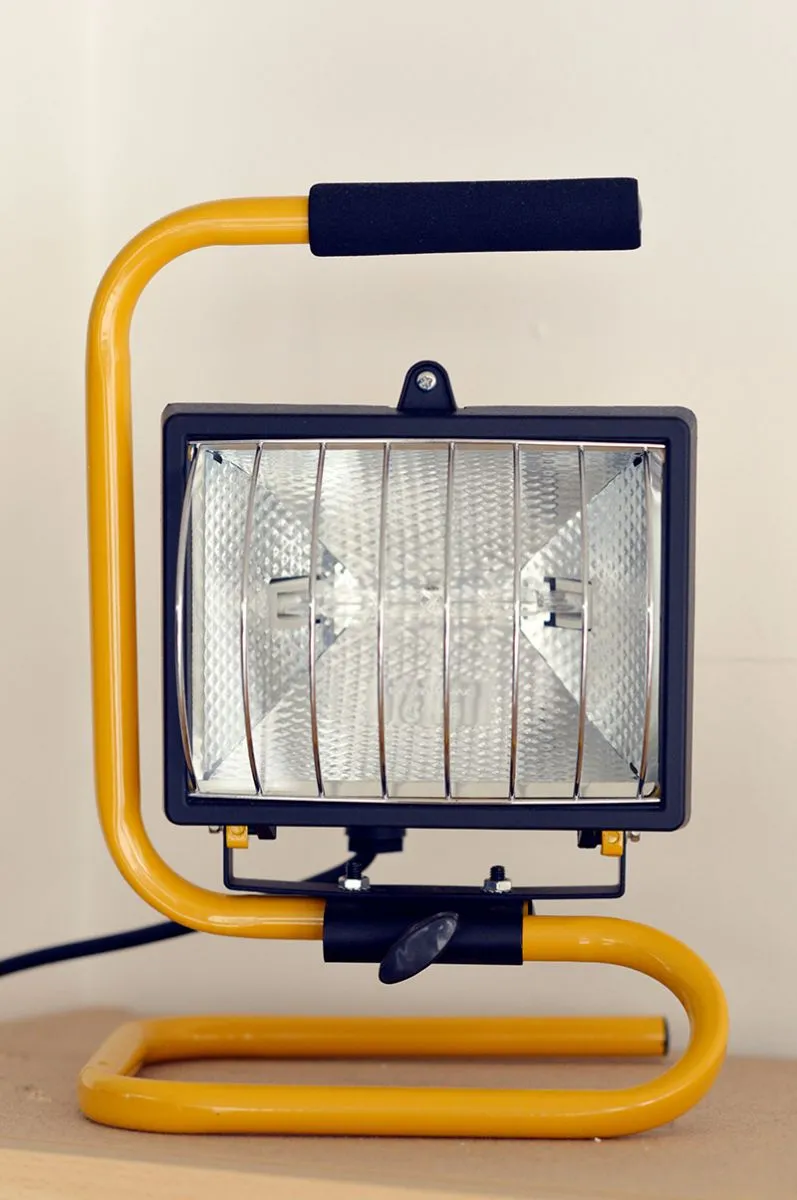
(Photo © 2013: Jens Brüggemann - http://www.jensbrueggemann.de)
3.4 HMI lamps
HMI lamps are discharge lamps that enable continuous lighting operation. Both color temperature (equivalent to daylight) and output remain largely constant over the entire burning time. Their greatest advantage is therefore that they can be used together with natural daylight in mixed lighting situations. Their light can also be measured using the light meters built into the cameras, which makes them easy to use for beginners. The efficiency is relatively high for continuous light sources: approx. 25% luminous efficacy.
However, the disadvantages show that HMI lamps are only used for special photographic purposes: The prices of HMI lamps (and the associated burner) are very high. Their output can only be adjusted minimally (by one f-stop). They generate a lot of heat, which is why no material-based light shapers (such as the popular softboxes or umbrellas) can be used with them. The cheaper versions are unsuitable for photographic purposes due to flickering.
Conclusion: HMI lamps are more suitable for filmmakers than for photographers. Strong heat development, low control range and dangerous UV radiation if used incorrectly make it clear that they do not meet the requirements of us photographers.
3.5 Daylight-like fluorescent lamps
Fluorescent lamps are relatively inexpensive. They are usually offered in multiples as panel lights in a sturdy housing (see photo below). Their output and color temperatures remain reasonably constant over the entire burning time.
Some of them provide halfway daylight temperature, which is why they can also be used well in mixed light situations and their light can also be easily measured with the light meters built into the cameras. Their heat generation is low and their efficiency (at approx. 15%) is acceptable.
Figure 3.8: Fluorescent lamps only provide approximate daylight temperature. Due to their limited selection of light shapers, they are intended less for photographic purposes and more as film light!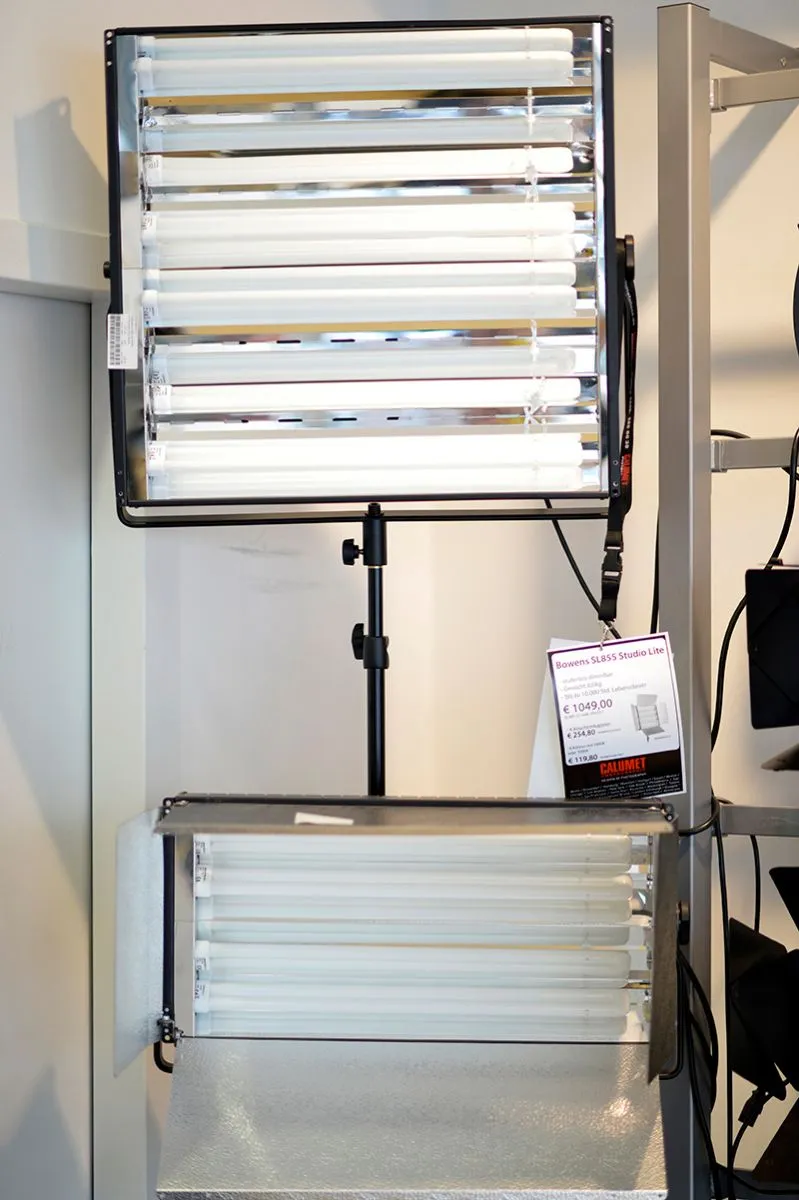
(Photo © 2013: Jens Brüggemann - http://www.jensbrueggemann.de)
However, the disadvantages outweigh the advantages if you want to use them for photographic purposes: The light characteristics can hardly be changed, they are primarily area lights. With higher wattages (= larger number of fluorescent lamps used), the dimensions of the lamp increase, they become unwieldy and are also sensitive during transportation.
If you buy cheaper versions, the flickering is annoying. The color temperature also (then) only approximates daylight.
If you just want to make it "brighter", these panel lights are fine to use. However, if you want to be creative with light, you need to look for a light source that allows you to use as many different light shapers as possible. Fluorescent lamps are unsuitable for this.
3.6 LED lights
LED lights have so far only been used to a limited extent in photography, primarily as modeling lights. However, the further development of these energy-saving lamps will ensure that their use as photographic light will also increase.
There are already developments where the LED light is not only used as a modeling light, but also as a supplementary flash light for photography.
Figure 3.9: LED area lights (which consist of many individual LEDs) are not very common in photography, unlike in the video sector. Why should we use continuous light (with all its disadvantages) when there is a wide range of suitable flash systems available?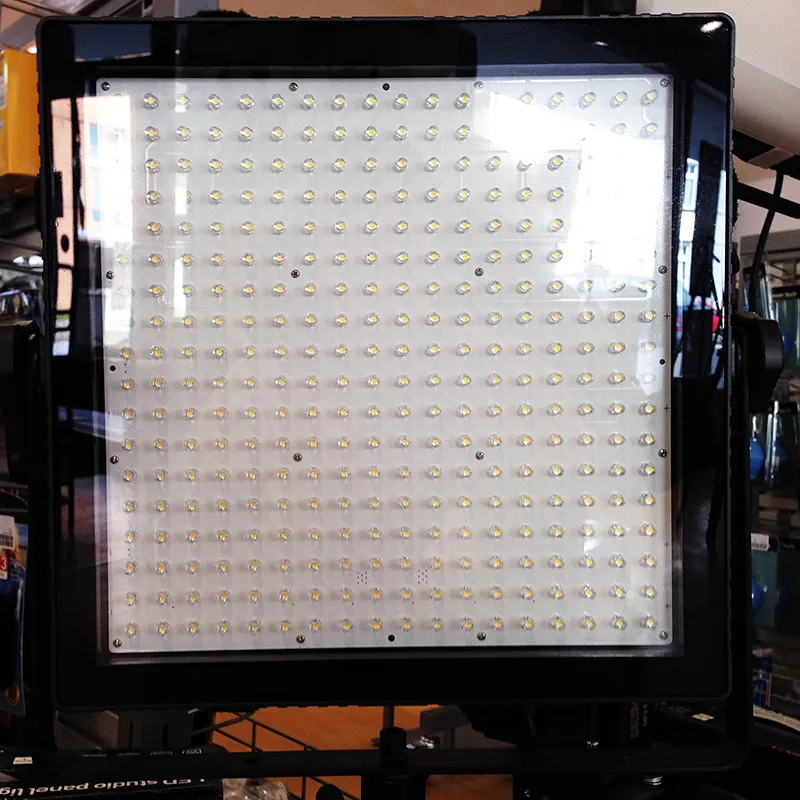
(Photo © 2013: Jens Brüggemann - http://www.jensbrueggemann.de)
Figure 3.10: LED lamps do not only have to function as (energy-saving) modeling lights. There are also new developments that make it possible to flash with the LEDs: "The LED array can be used both as a modeling light and as a flash light. As a flash light, it has an extremely short flash duration of approx. 1/15,000 sec."(http://www.priolite.com/de/produkte/details-priolite/items/priolite-mb500.html).
Shown here is the front view of the professional compact flash unit Priolite MB500. This flash can be used with a conventional omega flash tube as well as with the centrally arranged powerful LEDs. However, the color temperature is then 6,500 Kelvin and is therefore no longer daylightfast, but somewhat "colder". Nevertheless, this is an interesting and forward-looking alternative.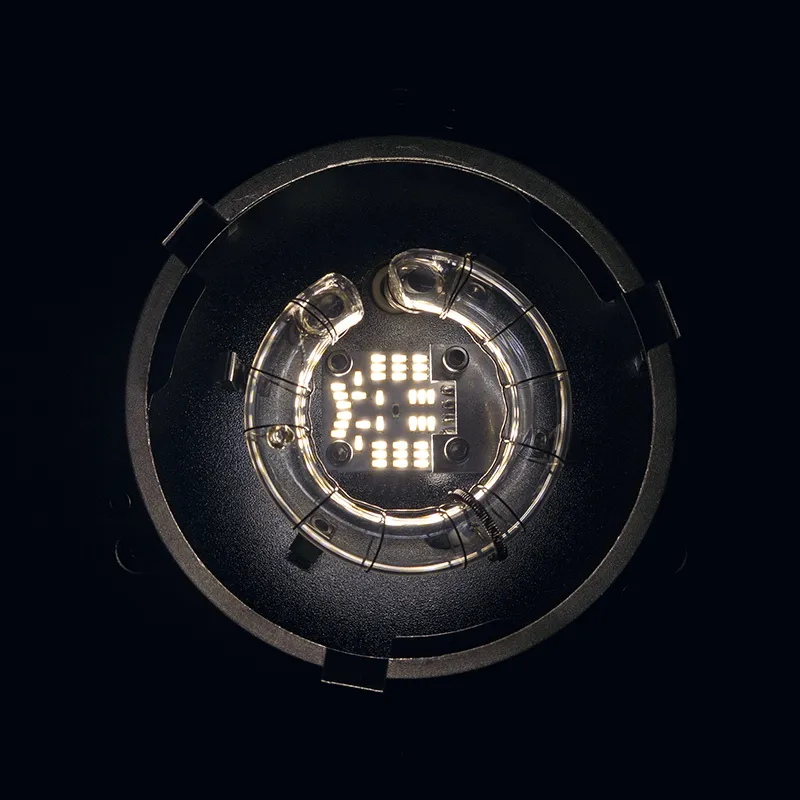
(Photo © 2013: Jens Brüggemann - http://www.jensbrueggemann.de)
Despite these new developments, the current status is still such that LEDs are primarily used in the photographic sector as pure modeling lights. In the video and film sector, they have long been established as continuous lighting.
System flash units
System flash units are comparatively inexpensive. Between 200 and 440 euros, you get a lot of power for your money. However, their biggest advantage is their compactness, independence from the mains supply and low weight. A system flash unit is therefore part of every photographer's basic equipment.
Other advantages include first-class efficiency (at around 50%), almost daylight temperature (system flash units are somewhat colder, with a color temperature of up to 6,000 K), a wide control range, automatic functions (including the ingenious TTL, which controls the flash output so that the photographer does not have to worry about the light quantity), almost no heat development and the possibility of ultra-short lighting times (ideal for freezing movement).
Figure 3.11: System flash units have many advantages, which is why they should not be missing in any photo backpack. However, you should only buy models that have a swivel reflector. Unless you want to use them as slave flashes in addition to the main flash. However, if you use the flash on your camera, a swivel reflector is an absolute "must have", as this is the only way to flash indirectly over a brightener, a white ceiling or a white wall. Direct flash, on the other hand, should be largely avoided, as the resulting shadows, light fall-off and harsh light are not the ingredients for an atmospheric photo.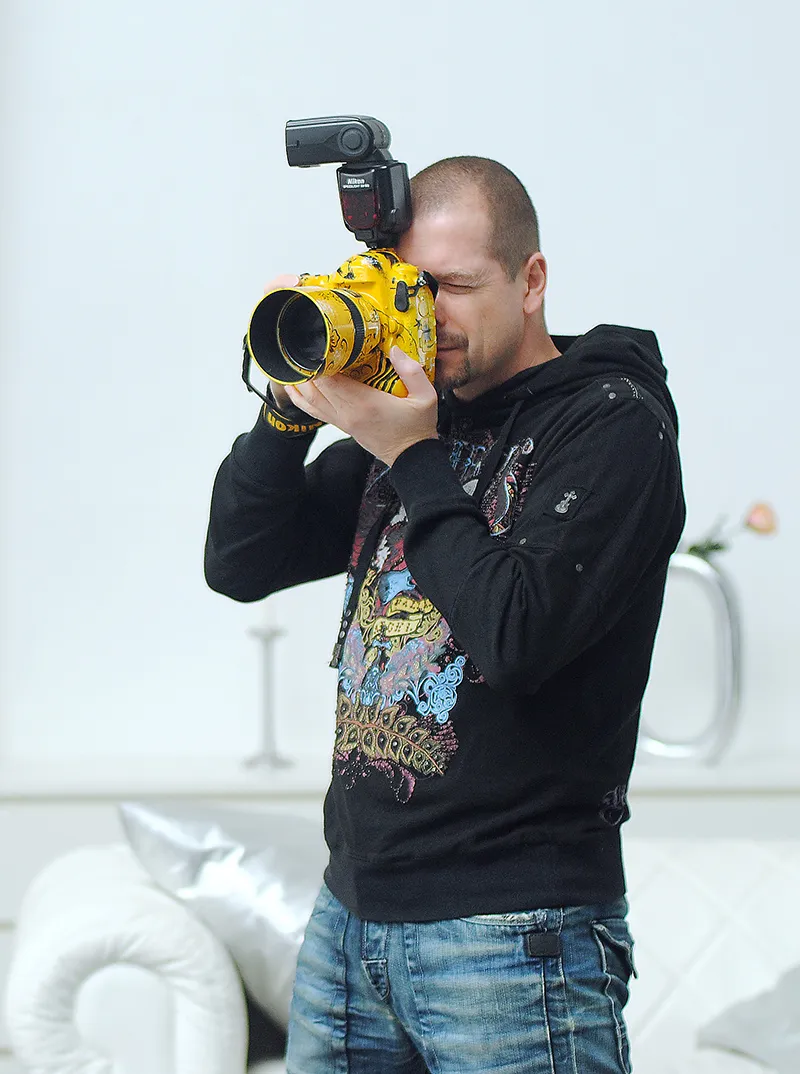
(Photo ©2013: Hodzic)
However, system flash units also have disadvantages: they do not have a modeling light with which creative lighting can be assessed. The results are therefore always somewhat arbitrary at first.
Only with a lot of experience can the light pattern be estimated. The available light shapers are nowhere near the quality of the large flash systems.
This is due to the light itself, but also to the size of the flash and the light shapers used. A beauty dish on a system flash, for example, has a completely different lighting effect than a beauty dish on a studio flash system. In addition, the light itself appears much flatter, less three-dimensional (than with studio flash systems). Unfortunately, there is no better way to describe this - you have to see the difference!
Figure 3.12: Even outdoors, where it is actually already bright enough, system flash units can be used to reduce contrasts, for example. If, for example, the model is under the shade of a tree and the background consists of (bright) sky, the flash (used here unleashed) serves to photograph the model in such a way that the sky is not outshone, but can be reproduced with detail.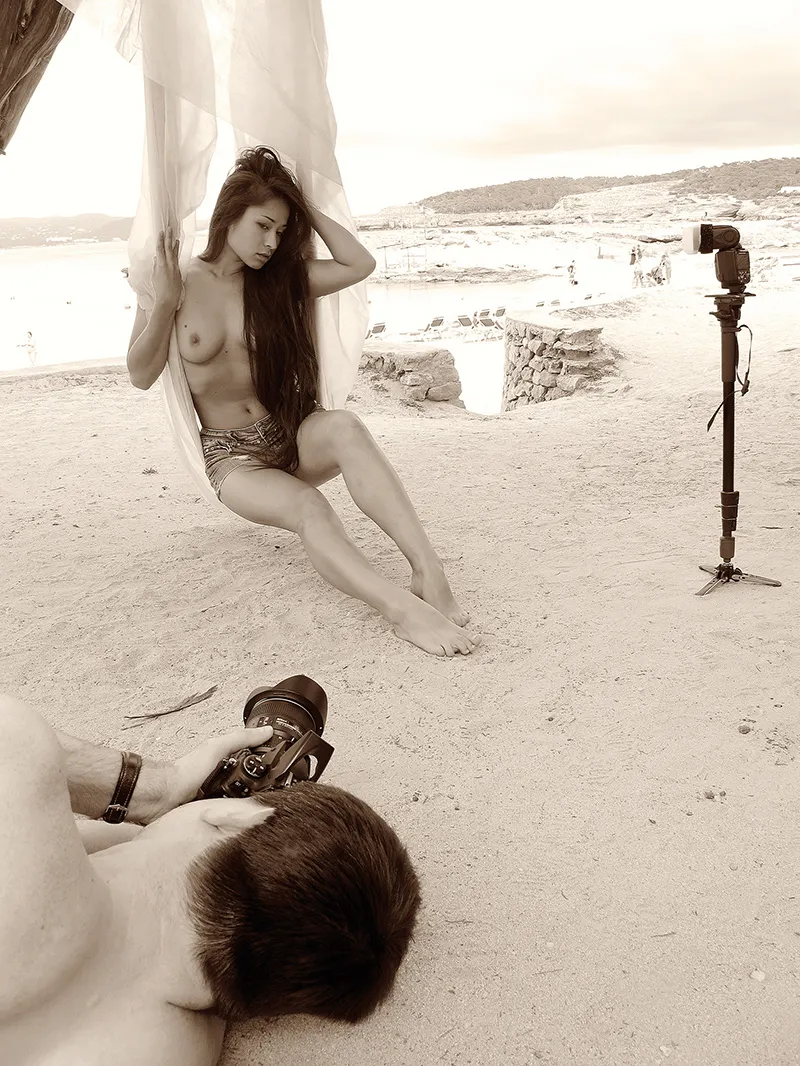
(Photo © 2011: Jens Brüggemann - http://www.jensbrueggemann.de)
Without a flash, on the other hand, either the model would be severely underexposed (but the sky would be blown out) or the model would be correctly exposed (but the background would be blown out). I doubt, however, whether the plastic diffuser attachment ("yoghurt cup") has any significant effect ... In any case, larger softboxes are better to achieve a softer light from the system flash.
Conclusion
A system flash unit should be part of every photographer's equipment! TTL control in particular makes working with these electronic flash units child's play. The system flash is ideal for party photos, reportage photography and anywhere else where small dimensions and low weight are required. However, when it comes to styled photography with precise light control and the ability to change the light characteristics, they are also suitable, but ultimately only second choice. This is because studio flash systems were designed for such applications.
Figure 3.13: System flash units are ideal for spontaneous photos, for example of the family or parties. If you swivel the reflector of the flash against a white ceiling or wall, you also get a nice soft, even illumination; not only of the people photographed, but of the whole room (in small rooms).
(Photo ©: Jens Brüggemann - http://www.jensbrueggemann.de)
Figure 3.14: Comparison table of system flash units versus studio flash units
System flash units | Studio flash system | |
strong modeling light | +++ | |
Large selection of light shapers | + | +++ |
compact | +++ | |
easy to handle | ++ | ++ |
light quality | + | +++ |
Light quantity | + | +++ |
price | ++ | + |
quick to use | +++ | |
suitable for moving objects | +++ | + |
creative possibilities | ++ | +++ |
expandable | + | +++ |
Camera system independent | +++ |
Flash units
Like system flash units, flash units belong to the category of electronic flash units. As there are some significant differences in terms of advantages and comparability to the other light sources already described, the flash unit category is normally divided into studio flash units and outdoor flash units. However, there are current tendencies that this distinction will soon belong to the future, because an expansion of the range of functions and thus the intended use can be observed in both outdoor flash systems and studio flash systems; with the result that the differences are becoming blurred. But more about this in the next part of this tutorial (Part 4: "Requirements for professional flash systems").
Flash systems are characterized by their versatility, as the range of light shaping accessories is large. The maximum output is also a frequently heard purchase criterion, although the minimum output has recently also become increasingly important (for portrait photos with an almost open aperture). The control range should therefore be as wide as possible in order to achieve both "lots of light" and "little light" with just one flash unit. With modern high-quality generators, a control range of 10 f-stops is now common. With compact flash units, the control range is up to 7 f-stops (for example with the Profoto D1).
Figure 3.15: The "D1" compact flash units from Profoto are characterized by robustness and a large control range (7 f-stops).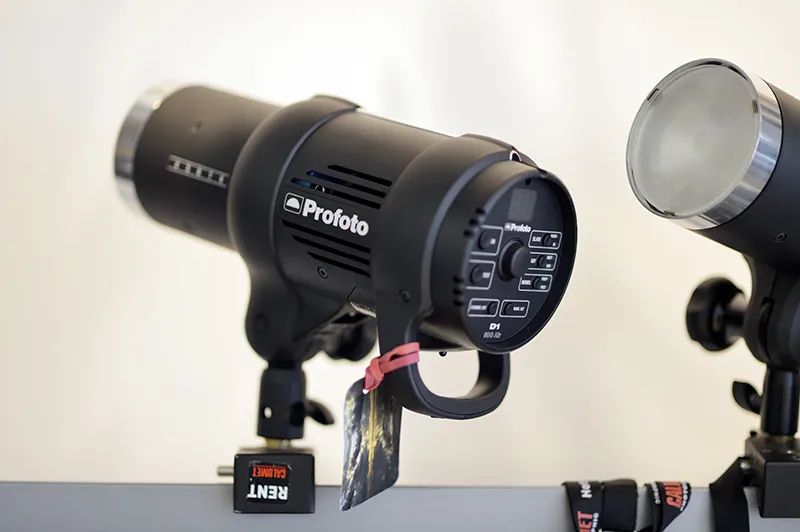
(Photo © 2013: Jens Brüggemann - http://www.jensbrueggemann.de)
In addition to the extensive possibilities for shaping the light according to your own ideas, the modeling light is the most important criterion for purchasing a flash system. Only with the aid of the modeling light can the light be set creatively.
This is not only eminently important for advertising product photography, ultimately the precise setting of the light is of great importance in all areas of creative photography. Durability (with quality flash units), constant daylight temperature across all power levels, expandability and camera system independence are further plus points in favor of flash units.
Figure 3.16: Since the modeling light in good flash systems is designed in such a way that its light curve roughly corresponds to the flash light, you can proceed according to the WYSIWYG principle, provided that no other lights (daylight etc.) interfere with precise work. The light can then be set precisely, as the modeling light shows how the flash light will run during the shot. Ideal for advertising photography, so that you can offer your customers an optimum result - also from a lighting point of view.
(Photo ©: Jens Brüggemann - http://www.jensbrueggemann.de)
On the other hand, there are the following disadvantages: Flash systems, if you pay attention to quality, are more expensive than other lighting solutions. They are often heavy and unwieldy; their area of application is not necessarily Mount Everest ... Replacements in the event of damage, for example if the glass breaks, are expensive, as replacement flash tubes can easily cost several hundred euros.
Conclusion on the subject
Flash systems are not for the small purse. However, the investment in a flash system must be considered in the long term. Unlike digital cameras, they do not become obsolete as quickly. Despite their high purchase price, they are the first choice for professional photographers and anyone who wants to work creatively with light.
Photographers who can do without continuous light and its disadvantages (because they are not shooting video clips) are best off with a combination of flash unit and system flash. This means you are ideally equipped for all photographic tasks.
Figure 3.17: The light from professional flash units has a completely different (higher) quality than all the other alternatives presented here. The light appears more vivid, more alive. This makes them the first choice for professional photographers.
(Photo ©: Jens Brüggemann - http://www.jensbrueggemann.de)
Preview
Due to their outstanding importance for creative photography, the following 4th part of this tutorial deals with the requirements for professional flash systems.
